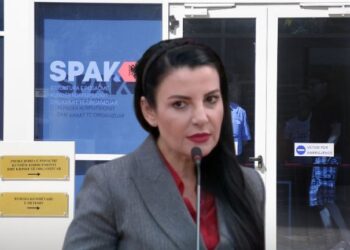The quarrying and quarrying business on Tomorri Mountain is leaving irreparable consequences on the ecosystem, natural habitats and landscape of the National Park.
First seen from afar, with its snow-capped top, which Andon Zako Çajupi called the “church of Albania and the throne of god,” Tomorri’s mountain looks majestic and beautiful as a postcard. But getting closer a little closer reveals that it is dry and filled with hollows that seem to go to the marrow.
Bulldozer and powerful excavator stroke on the stroke every day while hundreds of workers, day-night, pull out stone tiles to load into cars that leave behind thick dust clouds.
Announced four years ago as a protected area, Tomorri mountain is more like a huge quarry, for which environmental activists say it is one of the biggest ecological massacres ever happening in Albania.
On both sides of the road that leads to the mountain are tons of stones, powerful tools that erode the mountain, stone workers provide survival, and large cars that move over and over to the city of Poliçan.
Dozens of companies operating in stone quarrying work in the area, though an exact list of operators is difficult to find because of the high level of informality.
The head of the State Environmental and Forestry Inspectorate, Ergys Agasi, admits that often companies operating quarries have failed to respect the environmental permits they are licensed, but he underlines that the number of companies operating totally without a license is minimized.
“We are aware that the situation in Tomorri Mountain is problematic and I have ordered all companies there to reapply for a new environmental permit as a single condition for doing their business,” Agasi told BIRN.
Out of control
As soon as he enters the town of Poliçan, a large table informs visitors that Tomorri mountain has been declared a national park and protected by the state.
A Decree of the Council of Ministers no. 472, dated 18 July 2012, proclaims the natural ecosystem of the Tomorri mountain protected area on an area of 24.7 thousand hectares. According to the DCM approved by the center-right government of former Prime Minister Sali Berisha this area includes the municipalities of Roshnik, Vërtop, Bogovë, Gjerba, Zhepë and Kushovë.
In 2014, the government approved a management plan for the Tomorri National Park. The plan defines the stone quarrying business as a real threat to natural habitats and geological features of the area.
“It is necessary to close unlicensed quarries, excavations within the park area,” the 150-page document says.
However, as soon as you climb the mountain in front of the eyes, there are whole ruined surfaces, heavy machinery that scrabbles the skarpats, and workers who with levers extract the stone tablets from the ground.
Officially nobody knows how many employees there are in stone quarry businesses on Mount Tomorri, but the locals round off their number at around 150. When approaching, workers refuse to identify with a name because they say they may lose their job. They work from morning until evening for a monthly salary not exceeding 40,000 leks per month.
The national road from Poliçan to Novaj village, about 7 kilometers long, is overcrowded by stone processing factories. In terms of confidentiality, representatives of this sector told BIRN that there are 15 companies that deal with the extraction and processing of stone tiles. Each one emits 30 to 50 thousand cubic meters of stone, which is traded at a price of 30 euros per square meter, destined mainly for the foreign market.
In the city hall of Poliçan does not know exactly how many licensed companies are, because the administrative responsibility for Tomorri mountain is unclear. For the shak of the new administrative division, the Poliçan municipality is in a bureaucratic battle with Skarapar municipality, and it appears that until the final verdict nobody is responsible for what is happening in the protected area.
“We do not know how many companies operate on Mount Tomorri as the area is not administered by us,” says Anxhela Ibro – the public relations director in the Poliçan municipality.
According to the documents provided by BIRN there are 19 companies licensed to perform the stone extraction and processing activity on Mount Tomorri. It is not clear how many of these companies operate in the protected environmental zone.
The Regional Administrator of Protected Areas in Berat, Fatos Nako, told BIRN that the institution he leads is impossible to monitor the activity of these companies.
“From our information, only 7 hectares, it turns out that it has been damaged by this business, but we really have no information on how real the situation is, and our ability to control the terrain that is too difficult is extremely limited,” Nako said.
The lack of complete control of the area is also accepted by Chief Environmental and Forestry Inspector, Ergys Agasi, who states that the institution he runs and has the task of controlling the activity of private companies that have an impact on the environment has a limited number of employees.
“Currently, according to the documentation, only 8 companies are carrying out quarrying and stone processing, while it should be said that so far all the companies have been licensed to carry out this activity,” he said.
According to Agassi, the old environmental law had very low penalties for non-compliance with regulations on environmental permits, pushing companies to ignore them.
“The checks we have conducted on these campaigns are fine with all the documentation, and why none of them, after changing the location, has not done the rehabilitation of the area,” he said.
The Chief Inspector states that all the companies that have not rehabilitated the excavation have paid the National Agency of Natural Resources a value of 2.5 million leks foreseen as a penalty.
“Under these conditions, our inspectors, even when they find damage, are unable to act,” he said. “For this reason I have asked all companies to be provided with a new environmental permit, as the new law provides much more obligations.” Agassi added.
Marble Quarries
Marble quarries are considered as the Tomorian mountain gold mines. One cubic meter of this white stone, which the locals call marble, is shown at 500 euros. A company exits from the mountain an average of 4500 cubic meters of white stones per year.
To reach the location of these quarries, you have to leave behind the town of Corovode, settle through the gorge of Durrës and travel for 10 kilometers on a road that winds through Tomorri slopes. The source is called Tylova. Large white stone masses stand on the side of the roadside store in anticipation of the next buyer.
The revenue sector manager at Skrapar Municipality Sabri Alimadhi told BIRN that out of five licensed companies for extracting marble at the Illyrian field, only two of them exercise activity. On the ground the reality is quite different.
Nexhip Dhaja, the administrator of Stone Prodution, told BIRN that including his company the source is used by four companies, which large stone blocks pulled out of the mountain have deposited on the road to trade them.
The impact of quarries on the environment is the last thing that Xhaya is thinking of when it comes to stone extraction and stone processing. Its main concern is the high level of mineral rent but also the informality in this sector.
Chief Environment Officer Agasi does not rule out the possibility that there may be unlicensed activity in the Illyrian reservoir.
“The first job we have done is obtaining complete documentation for all companies operating in this area,” he said.
“I do not rule out that there are companies that are still active in the field, but we as the inspectors are prioritizing this issue,” Agassi added.
While law-abiding institutions in environmental protection are in the phase of re-licensing quarrying and stone processing businesses in Tomorri Mountain, civil society activists say this business is developing uncontrollably.
“Quarries in the Tomorr National Park have started early and now are scattered and are damaging it as it damages the mulberry tree. In the area where they have developed, they have irretrievably destroyed the ecosystem, natural habitats and landscape, “says botanist Ermelinda Mahmutaj.
“The big bad thing is that this business is expanding uncontrollably stretching across the surface of the protected area and seriously damaging it,” she added.
According to Mahmutaj, the most over-exploited area is the so-called P-side of Mount Tomorri, located on the town of Poliçan.
“At present, quarries have entered the park’s interior, in the Alpine pasture areas which in Tomorr are rich in endangered flora and endemic species,” Mahmutaj said.
“It is not known whether they have an environmental permit to use the rocks of the Alpine pastures of Tomorr National Park, but even if they do, it is unjustifiable for our environmental institutions,” she concluded.














